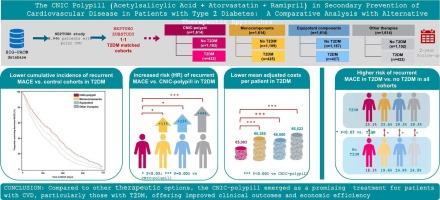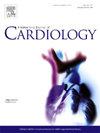The CNIC polypill (Acetylsalicylic acid + Atorvastatin + Rampril) in secondary prevention of cardiovascular disease in patients with type 2 diabetes: A comparative analysis with alternative therapeutic approaches
IF 3.2
2区 医学
Q2 CARDIAC & CARDIOVASCULAR SYSTEMS
引用次数: 0
Abstract
Background
Patients with type 2 DM (T2DM) and established cardiovascular disease (CVD) are at high risk of recurrent CV events. We analysed the use of the CNIC-polypill (acetylsalicylic acid, ramipril, and atorvastatin) compared with other therapeutic strategies in patients with T2DM and CVD from the retrospective NEPTUNO study.
Methods
Patients were stratified into four therapeutic approaches: CNIC-polypill, its monocomponents as loose medications, equipotent medications, and other therapies. Outcomes included the 2-year cumulative incidence and risk of recurrent major adverse CV events (MACE) and CV death, risk factors control, medication persistence, and utilisation of healthcare resources and costs.
Results
After two years, T2DM patients treated with Monocomponents, Equipotent drugs, or Other therapies had increased recurrent MACE risk compared to CNIC-polypill (11 %, 23 %, and 44 %, respectively; P < 0.05) and shorter median time to CV events (305–377 vs. 396 days; P < 0.05). The CNIC-polypill group achieved a significant 11.2 % increase in patients reaching LDL-c targets <70 mg/dL, outperforming other strategies. It also exhibited superior triglyceride control and a higher proportion achieving the <130/80 mmHg blood pressure goal. The CNIC-polypill cohort displayed significantly higher 24-month persistence (71.5 % vs. 54.7 %–58.3 %, p < 0.05) and lower mean adjusted costs per patient (€5083 vs. €6000–€6523; p < 0.05). In a comparative analysis, T2DM patients had lower baseline LDL-c and total cholesterol levels than non-T2DM counterparts yet experienced a higher incidence of recurrent MACE over two years.
Conclusion
The CNIC-polypill (ASA, atorvastatin and ramipril) emerged as a promising treatment for patients with CVD, particularly those with T2DM, offering improved clinical outcomes and economic efficiency.

CNIC 多效药(乙酰水杨酸 + 阿托伐他汀 + 兰普利)在 2 型糖尿病患者心血管疾病二级预防中的应用:与其他治疗方法的比较分析。
背景:2 型糖尿病(T2DM)和已确诊心血管疾病(CVD)患者复发 CV 事件的风险很高。我们分析了回顾性 NEPTUNO 研究中 T2DM 和心血管疾病患者使用 CNIC-多潘立酮(乙酰水杨酸、雷米普利和阿托伐他汀)与其他治疗策略的对比情况:方法:将患者分为四种治疗方法:方法:将患者分为四种治疗方法:CNIC-多丸剂、作为散剂的单组分药物、等效药物和其他疗法。研究结果包括两年内主要心血管不良事件(MACE)和心血管死亡的累积发生率和风险、风险因素控制、用药持续性、医疗资源利用率和成本:两年后,与 CNIC 聚能丸相比,接受单组分、等效药物或其他疗法治疗的 T2DM 患者的复发性 MACE 风险更高(分别为 11%、23% 和 44%;P 结论:CNIC 聚能丸的治疗效果更佳,但复发性 MACE 风险更高(分别为 11%、23% 和 44%;P 结论:CNIC 聚能丸的治疗效果更佳,但复发性 MACE 风险更高:CNIC-多丸(ASA、阿托伐他汀和雷米普利)是治疗心血管疾病患者(尤其是 T2DM 患者)的一种很有前景的疗法,可改善临床疗效并提高经济效益。
本文章由计算机程序翻译,如有差异,请以英文原文为准。
求助全文
约1分钟内获得全文
求助全文
来源期刊

International journal of cardiology
医学-心血管系统
CiteScore
6.80
自引率
5.70%
发文量
758
审稿时长
44 days
期刊介绍:
The International Journal of Cardiology is devoted to cardiology in the broadest sense. Both basic research and clinical papers can be submitted. The journal serves the interest of both practicing clinicians and researchers.
In addition to original papers, we are launching a range of new manuscript types, including Consensus and Position Papers, Systematic Reviews, Meta-analyses, and Short communications. Case reports are no longer acceptable. Controversial techniques, issues on health policy and social medicine are discussed and serve as useful tools for encouraging debate.
 求助内容:
求助内容: 应助结果提醒方式:
应助结果提醒方式:


